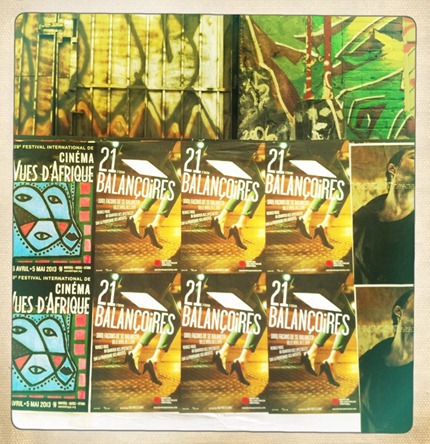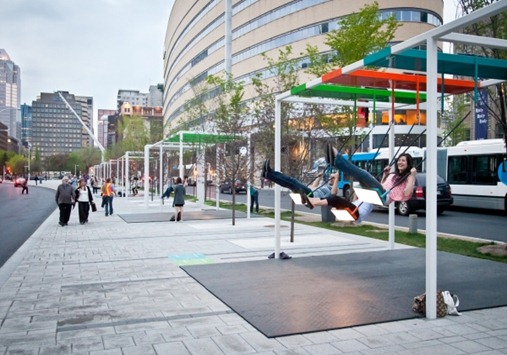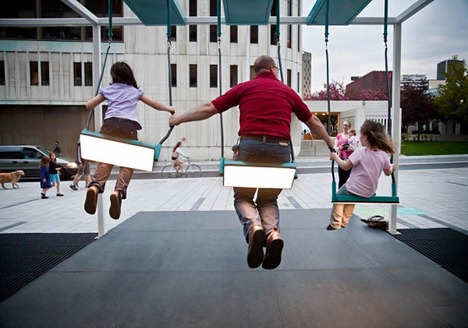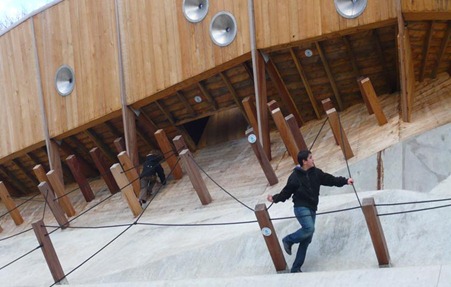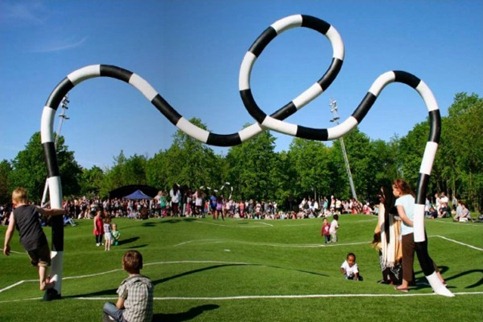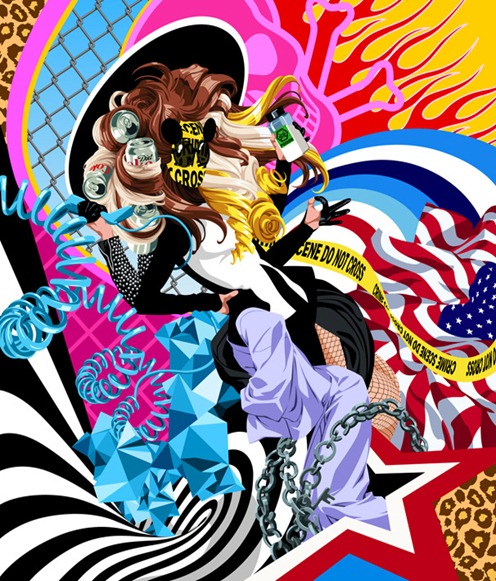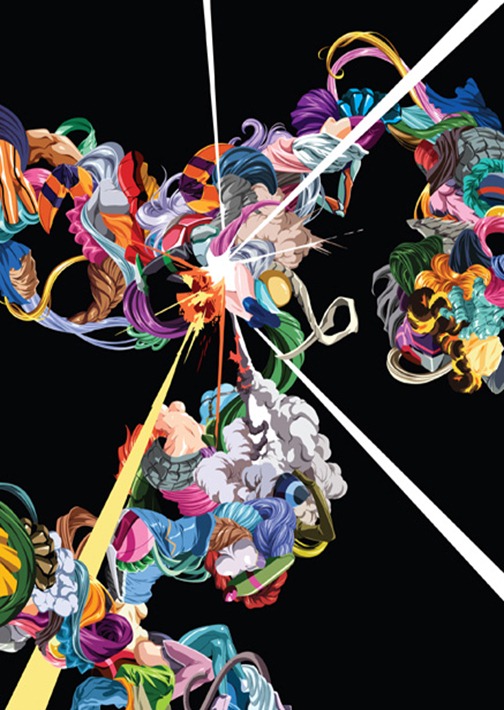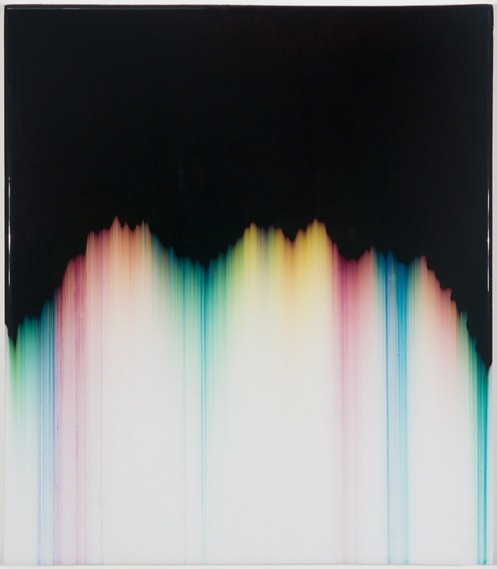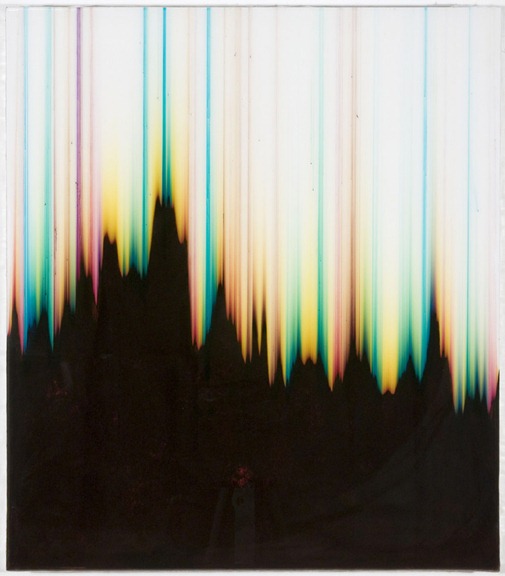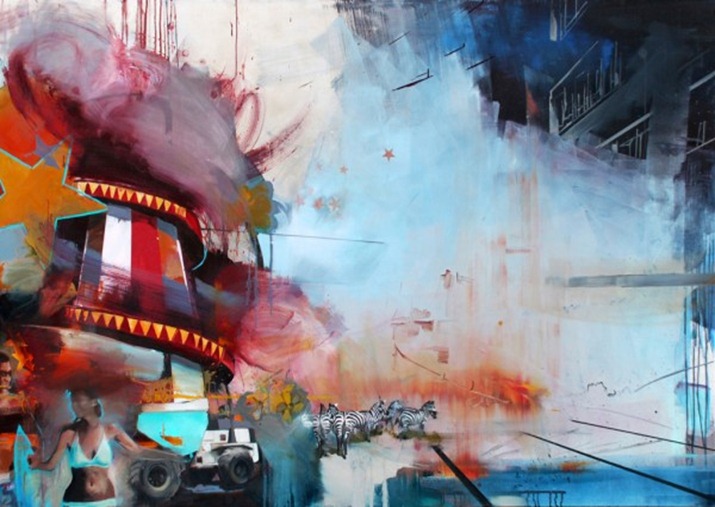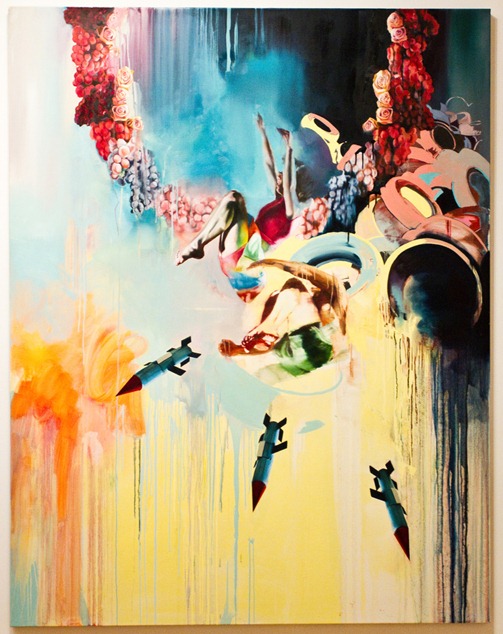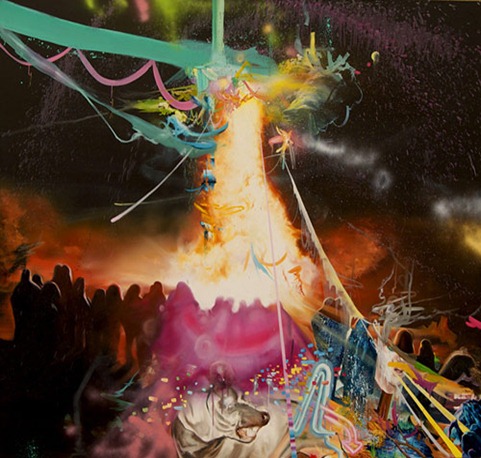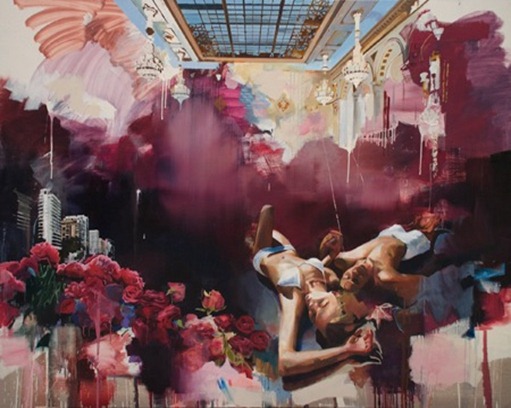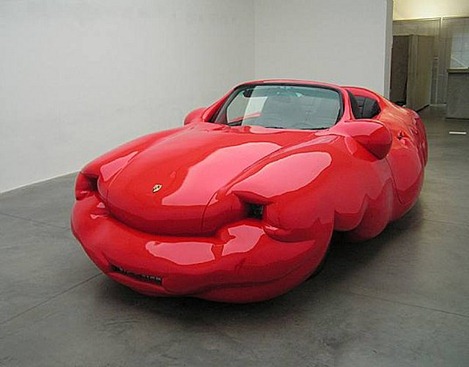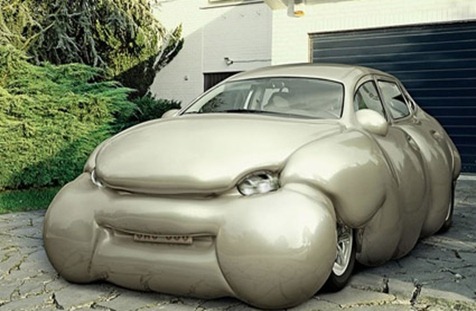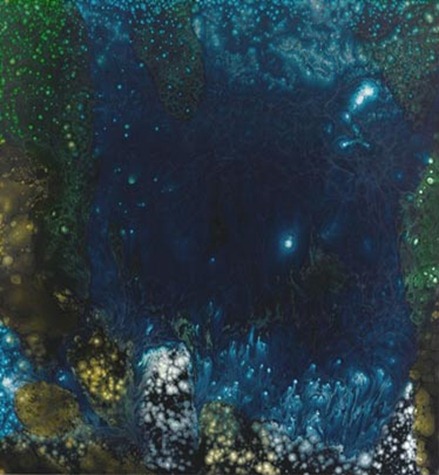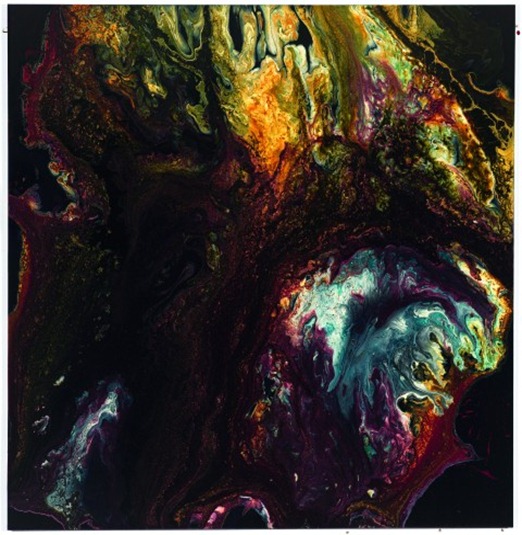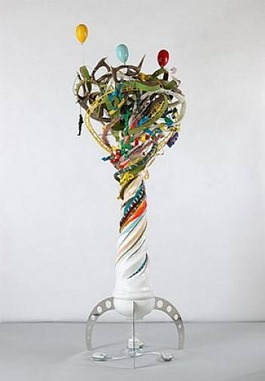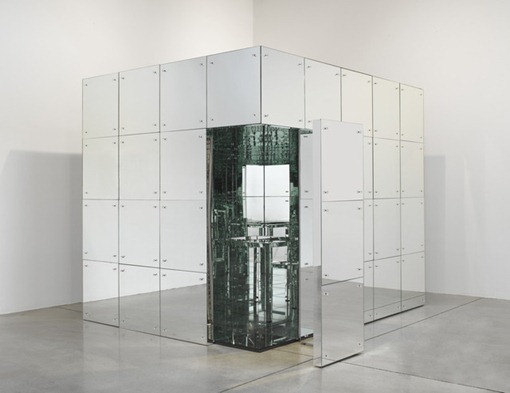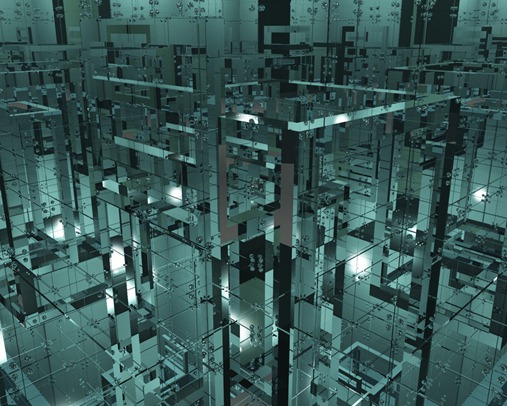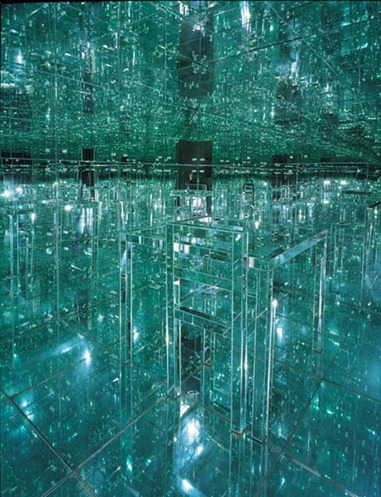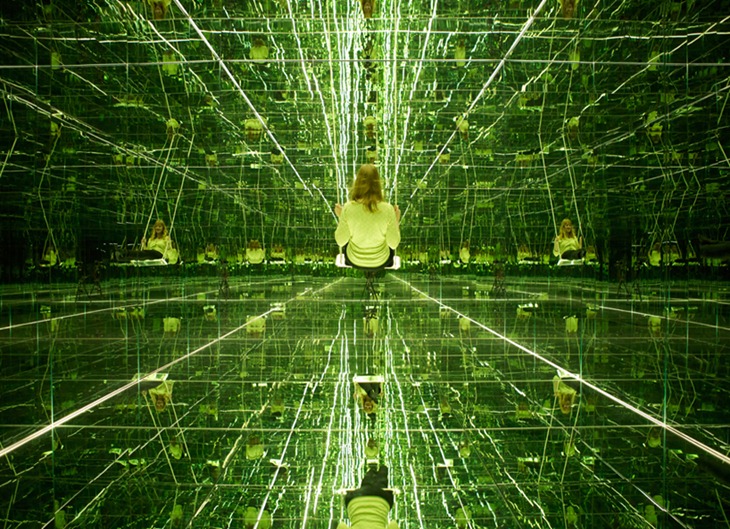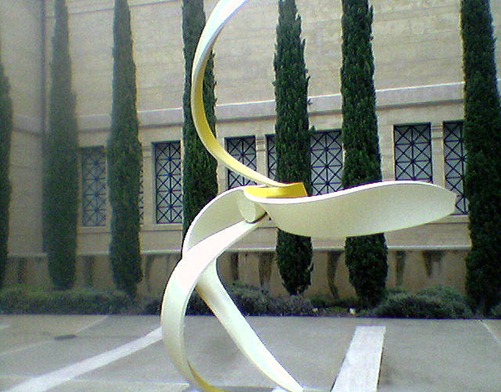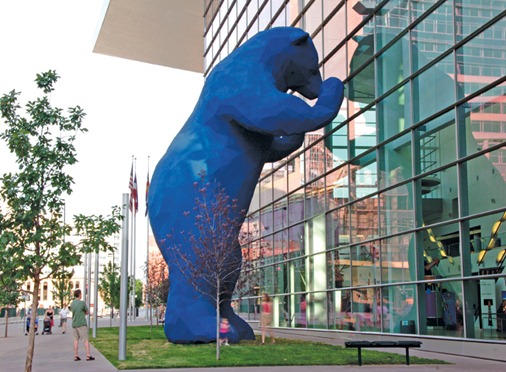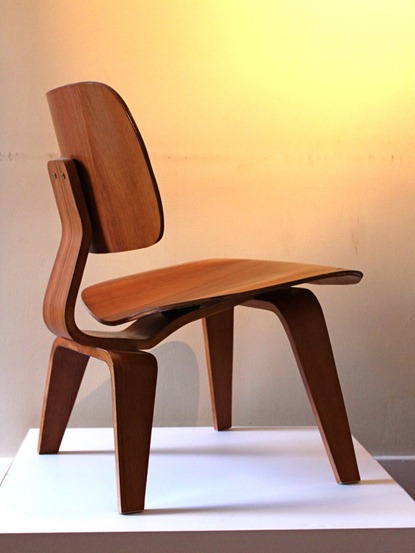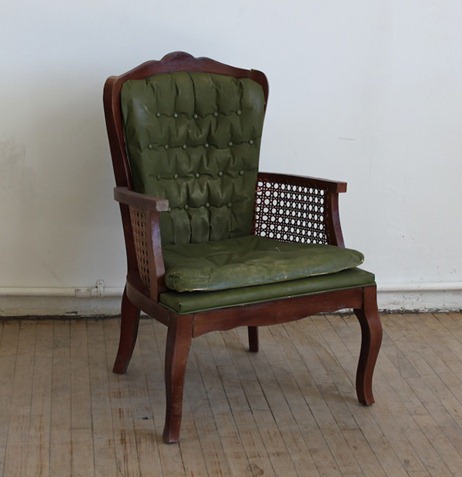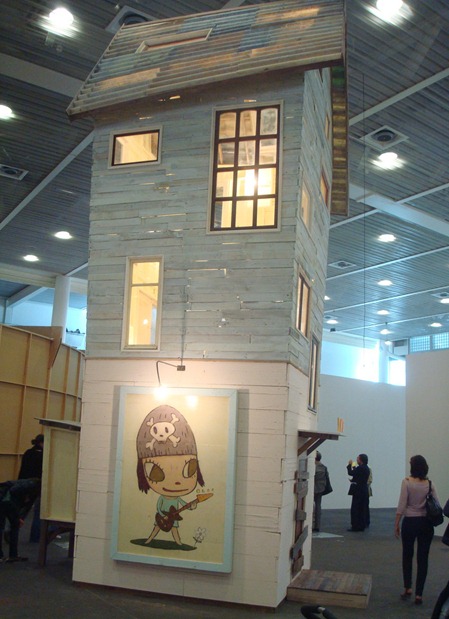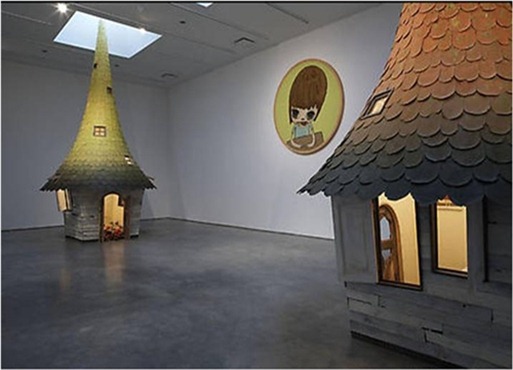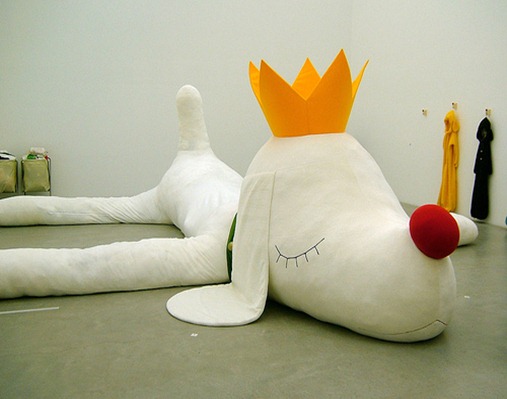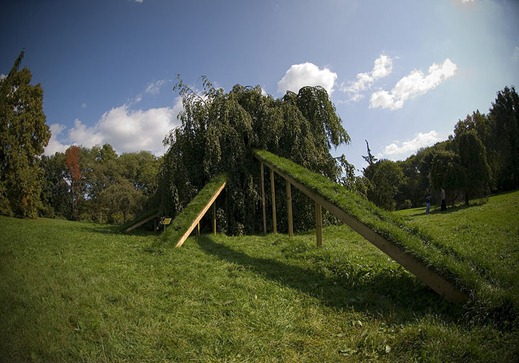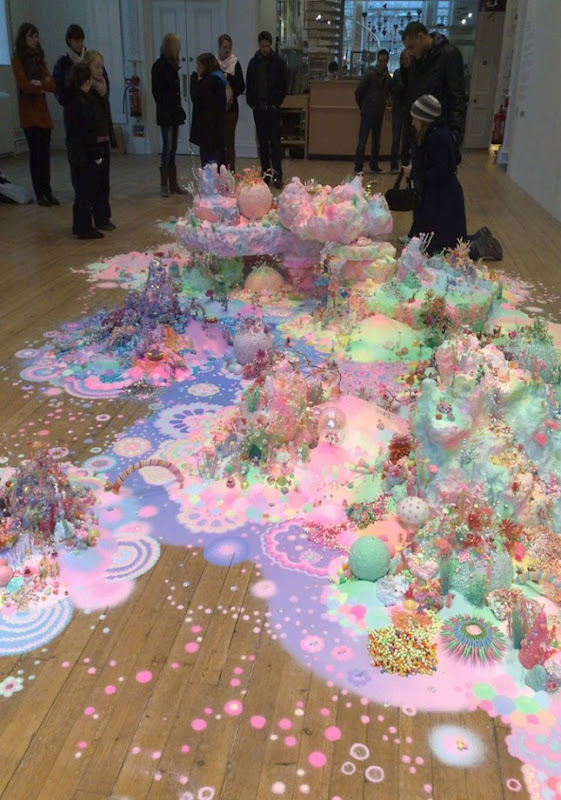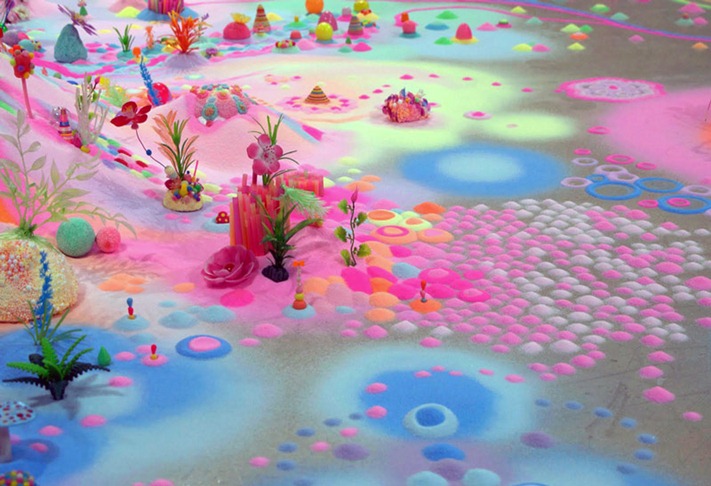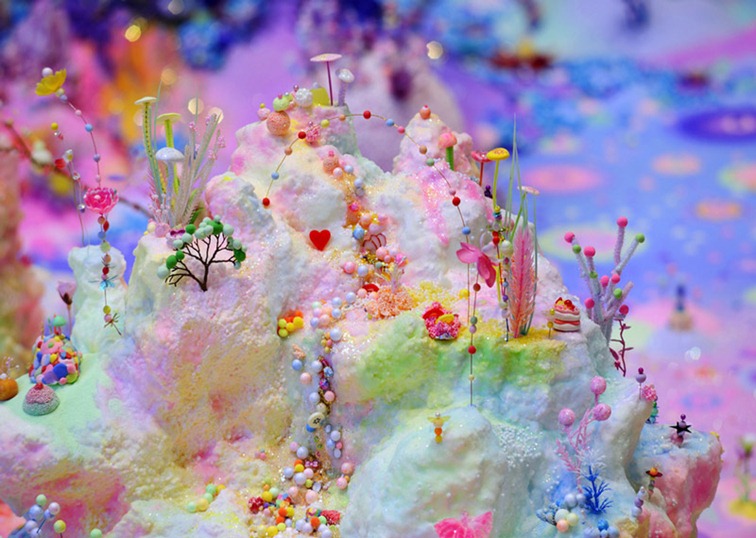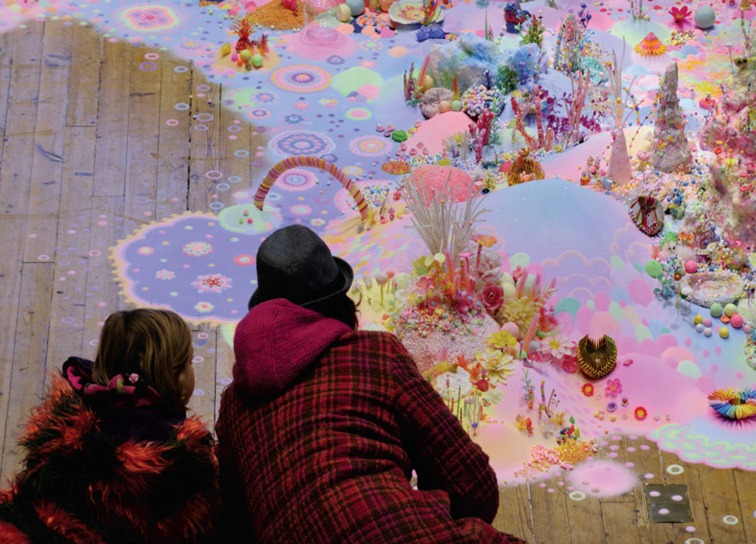April 15, 2013
PLAY AND PLACE
In the spring of 2011, twenty-one swings were built on the Promenade des Artistes, a small strip of urban space situated between two bustling streets, President-Kennedy and Maisonneauve, in the center of downtown Montreal. Creating a space of play in what otherwise would be another heavily-trafficked intersection of the city, the swings with their inviting colors and motion begged passersby to spare a few moments for pleasure before they crossed the street.
With a design meant to facilitate communication and coordination among both friends and strangers, each moving swing produced its own musical tones which, when combined with surrounding swings, could create harmonious melodies and spontaneous songs. Entitled 21 Balançoires, the installation represents a larger movement of artists, architects and urban planners working to integrate interactive, participant-oriented spaces into the “beaten path” of the everyday urban landscape: in other words, “making play space PATH, rather than DESTINATION”[1]. Accordingly, this sort of growing discourse of play makes one wonder: to what greater purpose do these mini-architectural works serve? Why are they becoming more important, more invested in than ever? To answer these questions, this paper will break down how the dissipation of interaction and the fragmentation of subjectivity within a postmodern, highly-mediated societal context necessitate these outlets for spontaneity, creativity and cooperation in more inclusive and readily accessible ways than ever. Looking at examples such as 21 Balancoires, the imaginative Belleville Park Playground in Paris and Malmo’s citywide park plan for place-making and place-keeping, I will argue that designing the city for play is crucial to restoring our society’s lost sense of place and community.
A study of the postmodern context of these emerging urban forms provides a necessary platform with which to understand the play initiative. The idea of postmodernity offered here is centered on the infiltration of media into all aspects of culture, to the extent that the world is always experienced as mediated. Primary experience has been replaced with new priorities, such as speed and efficiency, which cell phones, the Internet, and other technologies satisfy. According to Tajima, the convenience and widespread use of such media has conceived a global community in which location and time differences become obsolete:
New technologies have encouraged unrelenting time-less and location-less communication and information transfer. Asynchronous e-mail has allowed differences in time and place to disappear and the 24-hour global market or 'global city' to emerge.[2]
As Tajima notes, today’s city is at any one time is synchronized with the rest of the world, functionally inseparable from the media that makes it possible, and so place is insignificant. This external shift towards global rather than local preoccupations is most obviously represented by the proliferation of advertisements and logos for global corporations that conquer the urban landscape, from high to low, but is also physically evident in the clearing of public spaces such as offices and plazas. Since conference calls can be accessed from home, private conversations can be instant messaged online and people can silently text each other whether they are three or three million feet apart, “this invading wireless network diversifies the topology of the urban space, dramatically changing the use patterns of both public an
Along these lines, the consequence of the mediated or planned reality that Tajima describes is the emergence of the postmodern subject whose contours are defined by the objects he or she integrates into the self. This issue of uncontained subjectivity is outlined by Fredric Jameson in his idea of the “waning of affect”. Jameson describes these displaced subjects as formless and depthless, since their
liberation, in contemporary society, from the older anomie of the centered subject may also mean not merely a liberation from anxiety, but a liberation from every other kind of feeling as well, since there is no longer a self present to do the feeling.[5]
Accordingly, Jameson posits that postmodern subjects lack the presence, feeling and cohesiveness that used to either distinguish them from or identify them with other individuals and the built environment of the city. This inability to distinguish the individual from the mass is noted as he grimly calls the postmodern era “the end for example of style, in the sense of the unique and the personal, the end of the distinctive brushstroke”[6]. An example of this phenomenon can be summed up in the description of the archetypical postmodern subject, the “hipster”:
The hipster is a scholar of social forms, a student of cool. He studies relentlessly, foraging for what has yet to be found by the mainstream. He is a walking citation; his clothes refer to much more than themselves. He tries to negotiate the age-old problem of individuality, not with concepts, but with material things.[7]
Rather than establishing and expressing identity through habits, patterns of thoughts and actions on a moment-to-moment basis, the hipster instead reaches to a variety of outside or past sources to construct oneself much like an artist would construct a collage. Reconstituting diverse, discarded trends such as suspenders and big-framed glasses with an interest in artifacts of cultural nostalgia ranging from Nietzsche to Pokémon, these subjects at once represent and contribute to the disparate, over-saturated visual information of the postmodern landscape. The instability of producing an identity as such is that these material signifiers of individuality counterbalance and cancel each other out to the extent that any understanding of what makes the subject “in-dividual”, or whole, is far out of grasp. This ironic attitude towards the formation of identity, according to Wampole,
outside or past sources to construct oneself much like an artist would construct a collage. Reconstituting diverse, discarded trends such as suspenders and big-framed glasses with an interest in artifacts of cultural nostalgia ranging from Nietzsche to Pokémon, these subjects at once represent and contribute to the disparate, over-saturated visual information of the postmodern landscape. The instability of producing an identity as such is that these material signifiers of individuality counterbalance and cancel each other out to the extent that any understanding of what makes the subject “in-dividual”, or whole, is far out of grasp. This ironic attitude towards the formation of identity, according to Wampole,
signals a deep aversion to risk. As a function of fear and pre-emptive shame, ironic living bespeaks cultural numbness, resignation and defeat. If life has become merely a clutter of kitsch objects, an endless series of sarcastic jokes and pop references, a competition to see who can care the least (or, at minimum, a performance of such a competition), it seems we’ve made a collective misstep.[8]
As Wampole asserts, the decentralization of the subject via ever-quickening distancing devices, such as irony and cultural, rather than private, references, has produced a society in which genuine, slower communication based on patience and interpersonal depth is frequently avoided. Whether this shift comes out of simple convenience, or is the symptom of a larger emptiness felt by a demystified society, the message is clear: the postmodern population faces culture in fear of raw interaction and risk, to the extent that variation and diversity have been limited to culturally defined items and ideas that mediate individuals’ ability to think for themselves, to think outside of the consumerist “box”.
The over-programming of the individual outlined above is the current situation that urban planners, architects and artists are responding to when they construct pieces such as 21 Balancoires. By incorporating a loosely-interpretive structure, like the online interface that postmodern subjects are used to, into the urban landscape, the designers are hoping to redirect the population’s media fixation if only temporarily onto the physical world. With its lure as a respite from the controlled capitalist activity of everyday life, like a form of embodied media, the co-designer of the work Melisa Mongiat explains that “Each swing is an instrument for you to discover. Depending on how you swing, it generates different notes”[9]. In effect, the swings facilitate a social experiment with unknown outcomes and possibilities that depend on the unique, unplanned participation of each individual. In this way, the formation of the project can be described as an exercise of relational aesthetics, or what Bourriaud defined as “art that takes as its theoretical horizon the sphere of human interactions and its social context, rather than the assertion of an autonomous and private symbolic space”[10]. Originating in the 1960s as a form of protest against “the passive modes of engagement encouraged by late-capitalist, consumer-driven economies”, these works are partially-mediated, 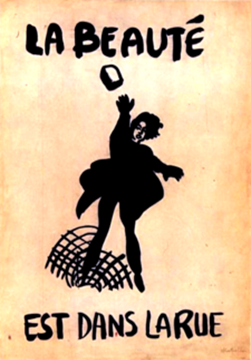 audience-activated to the extent that the contingency lies within the individuals[11]. For example, the politically engaged avant-garde group Situationist International of the 1960s arranged bizarre “Situations” that had participants spilling out of galleries and onto the streets, unifying art and life. The goal as such was to provide un-commodifiable, one-time experiences that facilitated “alternative models for social or political interaction” for its participants[12]. Like a contemporary “Situation”, Mongiat describes how creative and alternative experiences are inherent in 21 Balancoires’ design: “we install strange instruments, that people don’t know, in a public space and we try to see how they intuitively use it following the clues that we give them”[13]. Through experimentation, the users become active, rather than passive, consumers of culture. What the users will eventually learn through this process is the benefit of engaging with their social context, which becomes apparent when strangers collaborate alongside each other to make pleasing chords and songs.
audience-activated to the extent that the contingency lies within the individuals[11]. For example, the politically engaged avant-garde group Situationist International of the 1960s arranged bizarre “Situations” that had participants spilling out of galleries and onto the streets, unifying art and life. The goal as such was to provide un-commodifiable, one-time experiences that facilitated “alternative models for social or political interaction” for its participants[12]. Like a contemporary “Situation”, Mongiat describes how creative and alternative experiences are inherent in 21 Balancoires’ design: “we install strange instruments, that people don’t know, in a public space and we try to see how they intuitively use it following the clues that we give them”[13]. Through experimentation, the users become active, rather than passive, consumers of culture. What the users will eventually learn through this process is the benefit of engaging with their social context, which becomes apparent when strangers collaborate alongside each other to make pleasing chords and songs.
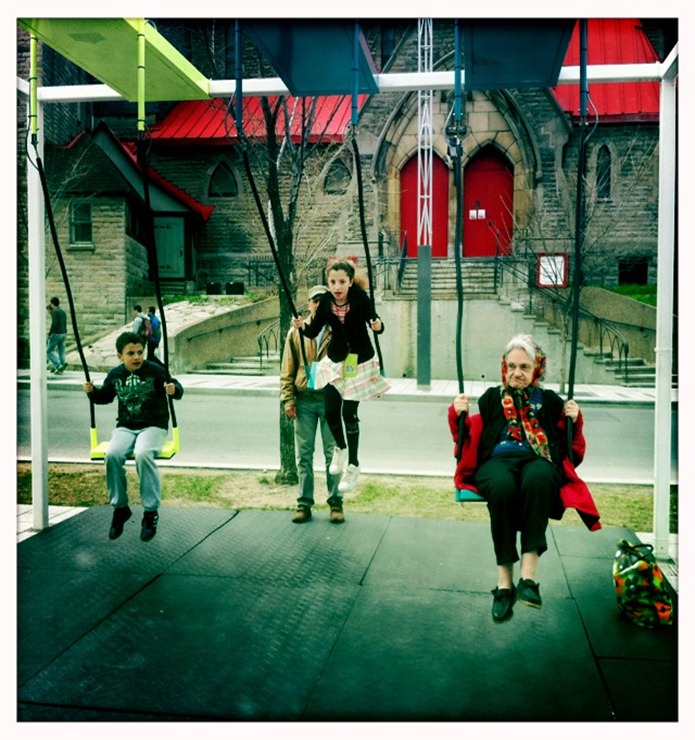
In effect, this work, like those of the Situationists, intends to show individuals how they can “take control of their own social and political existence”[14]. Along these lines, co-designer Mouna Andraos of 21 Balancoires was excited to see
the reflection that it sparks in people, like how we can work together in this context to create something beautiful, that could maybe apply a lot of other contexts where we want to come together to make something better.[15]
By providing individuals the instant gratification of the power of collaboration and of working in harmony, the swings motivate and teach the individual to engage and contribute to the social fabric of the city. The theory behind relational artworks ranging from “Situations” to the present-day 21 Balancoires illustrates how embodied participation can break down the barriers between art and its context, and therefore be an impetus for social communion and change.
Tangibly, these cases are situated within a larger discourse of artists, joined with urban planners and architects, who see embodied participation and play in particular as essential to the future of their cities. Why focus on cities, and why play? Franck and Stevens assert that cities are emergent with “loose spaces”, or spaces that exist in between constraining, commercialized spaces (i.e. offices, stores, apartments) and lack any restrictive purpose, definition or use.
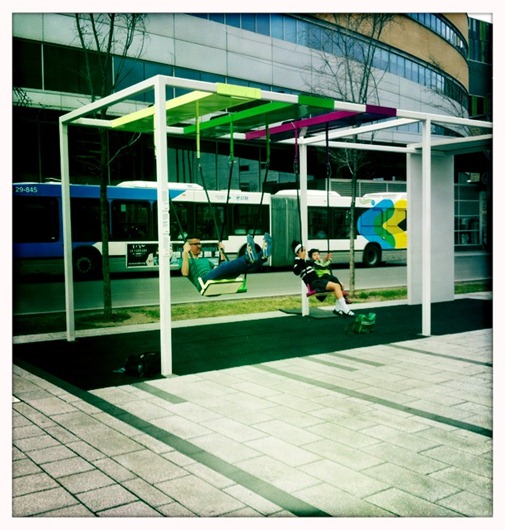 These spaces range from parks, waterfronts, and parking lots to flat rooftops and abandoned warehouses, and offer “opportunities for exploration and discovery, for the unexpected, the unregulated, the spontaneous and the risky”[16]. As such, both the inhabitants and the physical infrastructure contribute to how loose spaces begin to mean. These spaces are open to interpretation, and may be appropriated in both beneficial and harmful ways. The effort by designers to fill these loose spaces with positive connotations and inclusive activity is where the idea of play—for all-- becomes involved. In his book Play, Stuart Brown argues for the benefits of prolonging the desire and capacity to play, like children, into our adult lives:
These spaces range from parks, waterfronts, and parking lots to flat rooftops and abandoned warehouses, and offer “opportunities for exploration and discovery, for the unexpected, the unregulated, the spontaneous and the risky”[16]. As such, both the inhabitants and the physical infrastructure contribute to how loose spaces begin to mean. These spaces are open to interpretation, and may be appropriated in both beneficial and harmful ways. The effort by designers to fill these loose spaces with positive connotations and inclusive activity is where the idea of play—for all-- becomes involved. In his book Play, Stuart Brown argues for the benefits of prolonging the desire and capacity to play, like children, into our adult lives:
Many studies have demonstrated that people who continue to play games, who continue to explore and learn throughout life, are not only much less prone to dementia and other neurological problems, but are also less likely to get heart disease and other afflictions.[17]
As Brown states, the self and world discovery that comes with the relentless boundary-testing of play proves to be psychologically, and even biologically, advantageous. With this in mind, it makes sense that designers are looking to break down the metaphysical “fence” around the playgrounds of the city and begin to incorporate structures that harbor play of all ages into “loose”, generally adult-dominated spaces. If accessible and inclusive, urban play spaces can attract and encourage the postmodern subject to connect with his or her environment in honest ways in which gravity and the unknown are the only known order. The unconventional Belleville Park Playground in Paris, for example, merges a freely-interpretive,
sloped wooden climbing course (with obstacles) into winding paths that lead to the summit of this hill-top inner-city park. With its abstract design, the playground has been described in terms of “a mountain landscape, building site, flying carpet, machicolation, medieval fortifications, pirate ship rails, etc…”[18] Rather than experiencing the world from a safe mediated distance, one who decides to play in the Belleville Playground opens him or herself onto the realm of infinite possibilities,
of learning, risk and the imagination. Of course, the ability to facilitate such authentic experience, as Franck and Stevens touch on, is dependent upon how inspiring and stimulating the spaces or structures in question are. Thus, designing for the most fascinating, beneficial sort of play is crucial to the city’s process of place-making, or
creating high quality places that people want to visit, experience and enjoy. It implies a people-centred approach which emphasizes designing spaces that promote health, wellbeing and happiness. Such spaces engender a sense of belonging and connection for those who use them.
This definition, put forth in an assessment of Malmo, Sweden’s citywide playground project, asserts how play and community come together to make “place”. As a world-class destination for play, Malmo’s investment in twenty-two themed parks throughout the city provides the backbone to its distinction of “place”, to its
unified “master plan which aims to create a sustainable and attractive city”[19]. Encouraging place-making as well as place-keeping, the designers of the parks of Malmo engage with the social context of each particular park by allowing individual communities to choose the theme of their respective playground and discuss the ways they would like to use it. By aligning the city’s investment with the investment of the individuals involved, the plan promotes a lasting “positive  response to the project” in which users take it upon themselves to produce a space of mutual respect, spontaneous gathering, and pleasure[20]. Essentially, play turns “loose space” into invaluable, productive experience for its participants, and thus resituates the importance of interaction and physical place within the subject.
response to the project” in which users take it upon themselves to produce a space of mutual respect, spontaneous gathering, and pleasure[20]. Essentially, play turns “loose space” into invaluable, productive experience for its participants, and thus resituates the importance of interaction and physical place within the subject.
In conclusion, the changes in our built environment should reflect the changes we want to see inside of ourselves. Durkheim once posited that “great movements of feeling ‘do not originate in any of the particular individual consciousnesses,’ but come from ‘without’ (1966: 4)”[21]. In this sense, the collective spaces of the city should be seen as the groundwork, the starting point, for re-integrating subjects into their physical communities and places. Dealing with a postmodern crisis in which “man mentally isolates himself from the surrounding context until he reaches his destination” and hipsters (as walking reminders of consumer culture’s conquer over the individual) dominate the urban landscape, it is evidently more pertinent than ever to create spaces of genuine, rather than mediated, experience[22]. Borrowing ideas from the relational art movement of the 1960s, urban planners, architects and artists are responding to this crisis by building participant-activated structures, like 21 Balancoires and the Belleville Park Playground, that facilitate the play, risk and meaning that postmodern subjects lack in their hyper-programmed lives. Replacing the safe distance that communication technology provides with hands-on, embodied interaction, the play initiative unifies individuals and the community at large by teaching people the benefits of putting down one’s cell phone and engaging with a context or cause bigger than oneself.
[1] Johnson, Paige. "Merging Path and Playground." Playscapes - All the Best Playgrounds are Here. N.p., 21 Jan. 2013. Web. 16 Apr. 2013. <http://www.play-scapes.com/page/3/>.
[2] Tajima, Noriyuki. 2006. “Tokyo Catalyst: Shifting Situations of Urban Space”. P. 81. Perspecta 38
[3] Tajima, Noriyuki.38
[4] Tajima, Noriyuki.38
[5] Jameson, Frederic. 1984. “Postmodernism, or, The Cultural Logic of Late Capitalism”. New Left Review 146: 64
[6] Jameson, Frederic. 64
[7] Thomas, William G., and Leslie Working. "How to Live Without Irony."Opinionator - NYTimes.com. The New York Times, 17 Nov. 2012. Web. 16 Apr. 2013. <http://opinionator.blogs.nytimes.com/2012/11/17/how-to-live-without-irony/>.
[8] Thomas, William G., and Leslie Working. "How to Live Without Irony."
[9] Bouchard, Marie-Pierre. "21 BALANÇOIRES| Quartier des spectacles." Quartier des spectacles. N.p., 21 Apr. 2011. Web. 15 Apr. 2013. <http://www.quartierdesspectacles.com/en/2011/04/21-balancoires-a-musical-collaboration-from-andraos-mongiat-at-the-promenade-des-artistes/>.
[10] Bourriaud, Nicolas. Relational aesthetics. Dijon: Les Presses du réel, 2002. P. 160
[11] Dezueze, Anna. “Introduction,” The ‘do-it-yourself’ artwork: Participation from Fluxus to New Media (Manchester: University of Manchester Press, 2010). P. 16
[12] Dezueze, Anna. “Introduction,” P. 15
[13] Bouchard, Marie-Pierre. "21 BALANÇOIRES | Quartier des spectacles." Quartier des spectacles. N.p., 21 Apr. 2011. Web. 15 Apr. 2013. <http://www.quartierdesspectacles.com/en/2011/04/21-balancoires-a-musical-collaboration-from-andraos-mongiat-at-the-promenade-des-artistes/>.
[14] Dezueze, Anna. “Introduction,” P. 15
[15] Bouchard, Marie-Pierre. "21 BALANÇOIRES | Quartier des spectacles."
[16] Franck, Karen A. and Quentin Stevens. 2007. “Tying Down Loose Space”. P. 3. Loose Space: Possibility and Diversity in Urban Life. Oxford: Taylor and Francis
[17] Brown, Stuart L., and Christopher C. Vaughan. Play: how it shapes the brain, opens the imagination, and invigorates the soul. P. 25. New York: Avery, 2009. Print.
[18] Clancy, Joseph. "Playground in Belleville Park by BASE Landscape Architecture."Landscape Architects Network. N.p., 25 Aug. 2012. Web. 16 Apr. 2013. <http://landarchs.com/playground-belleville-park-base-landscape-architecture/>.
[19] Sonntag, Liv, and Nicola Dempsey. "Transnational Assessment of Practice: Theme Playgrounds, Malmo." Making Places Profitable 1 (2010): 2. North Sea Region. Web. 11 Apr. 2013.
[20] Sonntag, Liv, and Nicola Dempsey. "Transnational Assessment of Practice: Theme Playgrounds, Malmo." Making Places Profitable 1 (2010): 4. North Sea Region. Web. 11 Apr. 2013.
[21] Ahmed, Sara. 2004. “Collective Feelings: Or, the Impression Left by Others”. P. 28. Theory Culture Society 21:25
[22] Tajima, Noriyuki. P. 84.

